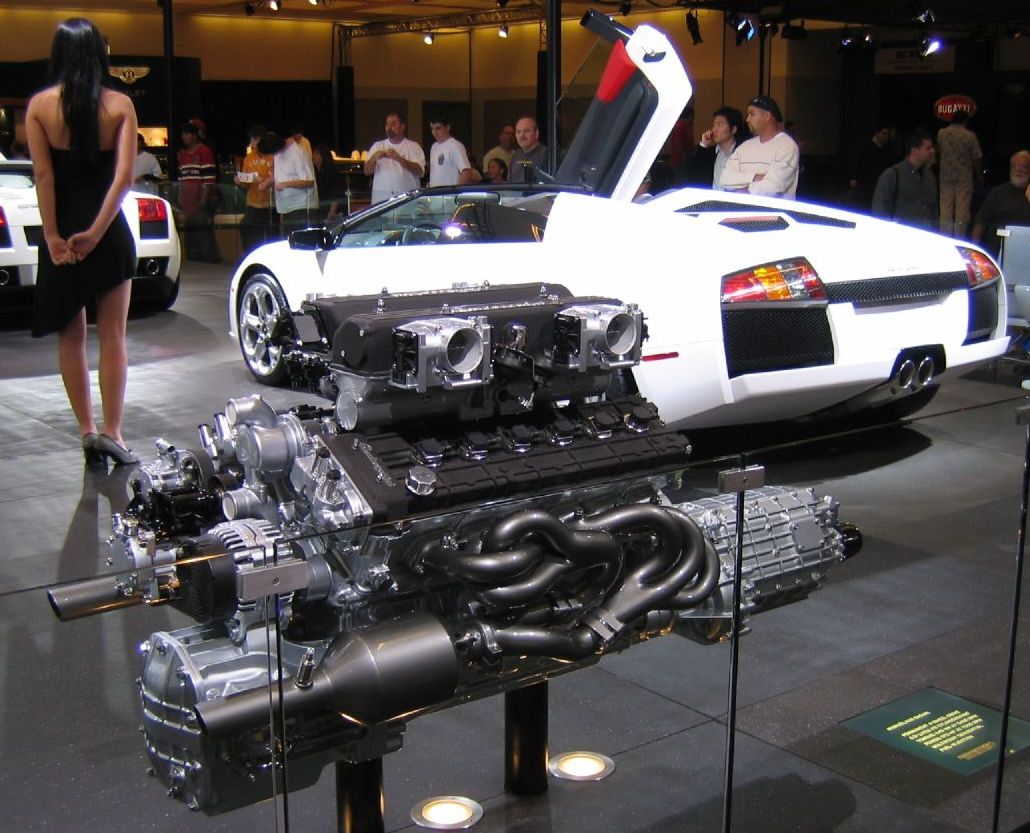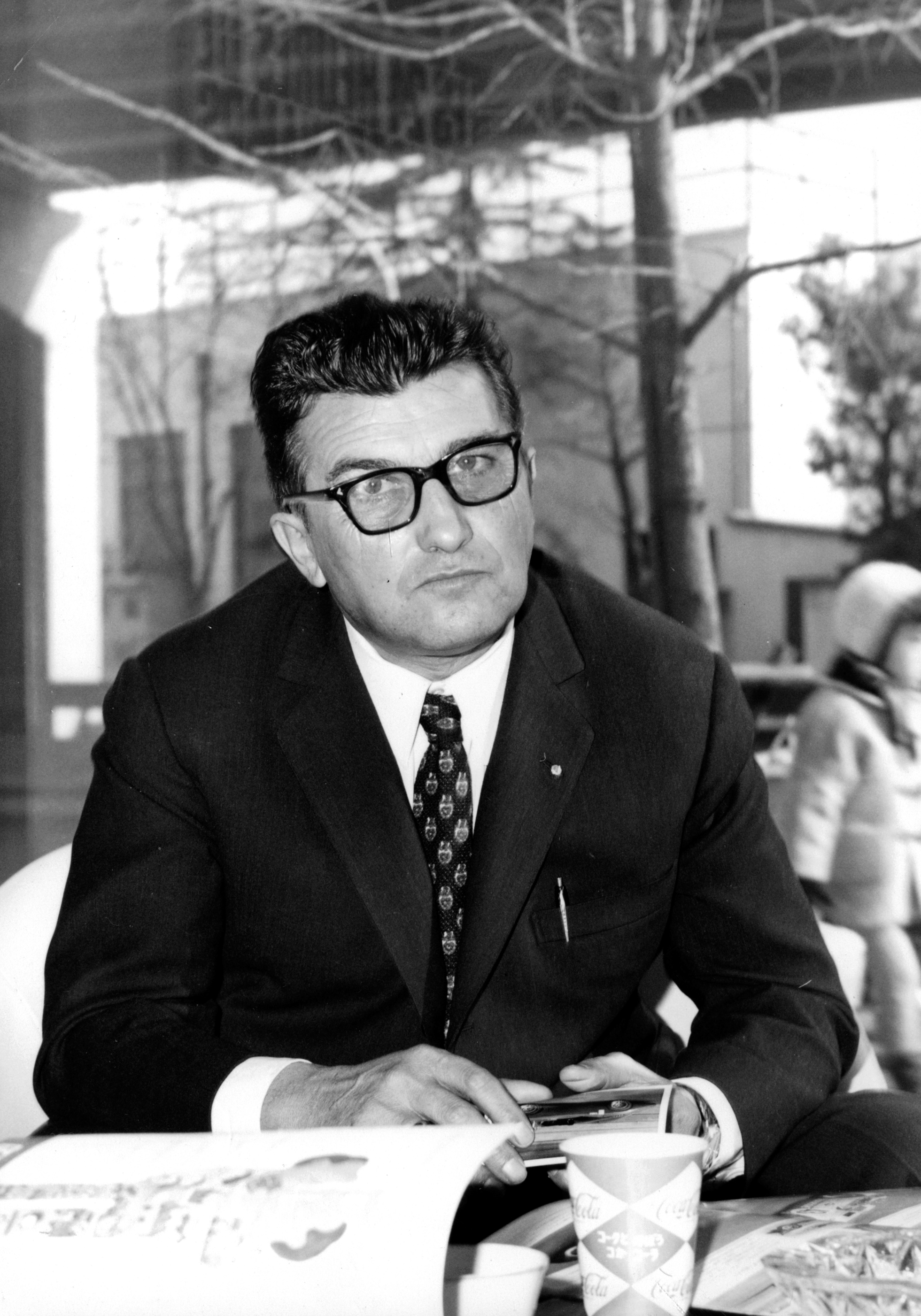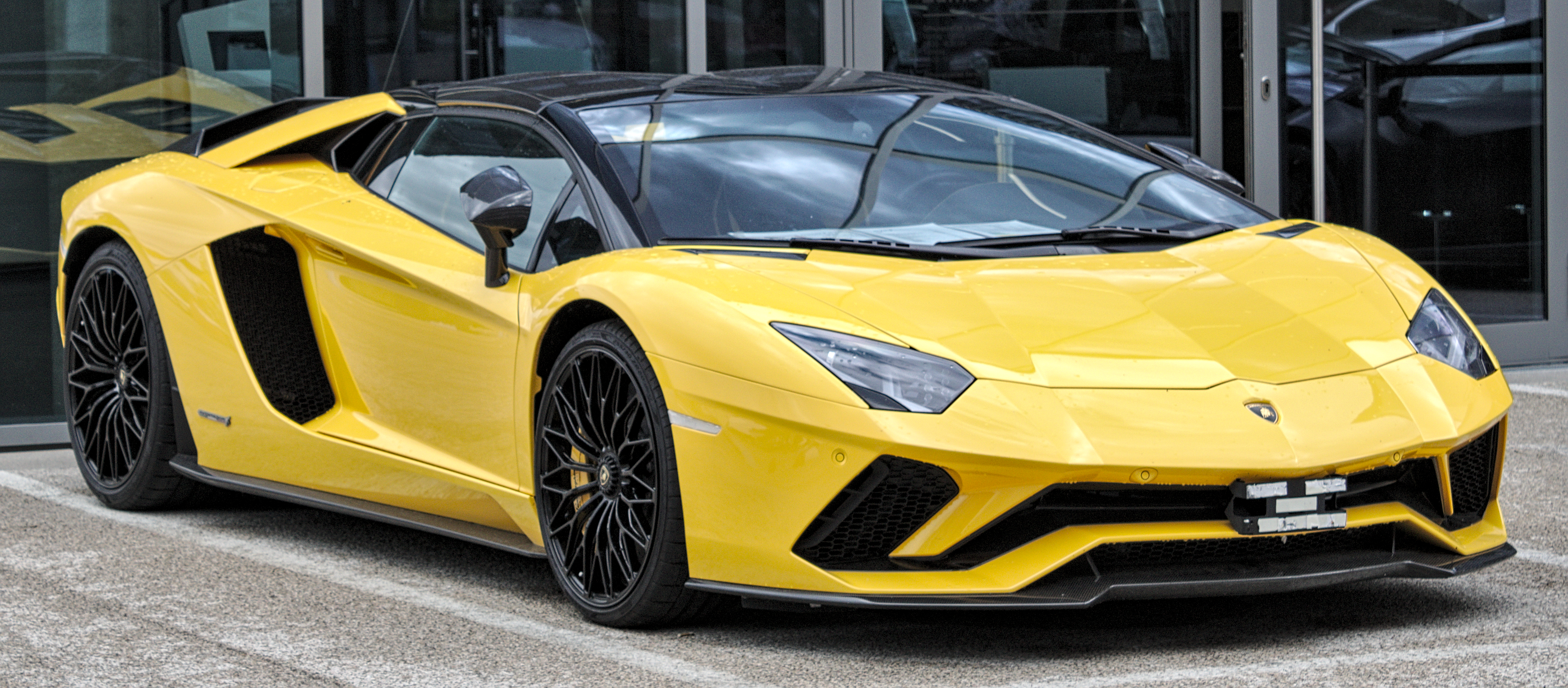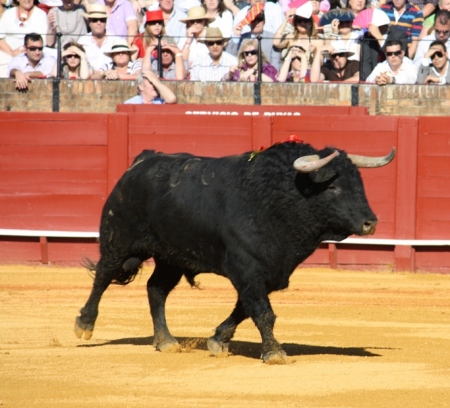|
Lamborghini Murciélago
The Lamborghini Murciélago is a sports car produced by Italian automotive manufacturer Lamborghini between 2001 and 2010. Successor to the Diablo and flagship V12 of the automaker's lineup, the Murciélago was introduced as a coupé in 2001. The car was first available in North America for the 2002 model year. The Murciélago was Lamborghini's first new design in eleven years, and was also the brand's first new model under the ownership of German parent company Audi, which is owned by Volkswagen. The car is designed by Peruvian-born Belgian Luc Donckerwolke, Lamborghini's head of design from 1998 to 2005. A roadster variant was introduced in 2003, followed by the more powerful and updated LP 640 coupé and roadster and a limited edition LP 650–4 Roadster. The final variation to wear the Murciélago nameplate was the LP 670–4 SuperVeloce, powered by the largest and final evolution of the original Lamborghini V12 engine. Production of the Murciélago ended on 5 November 20 ... [...More Info...] [...Related Items...] OR: [Wikipedia] [Google] [Baidu] |
Lamborghini
Automobili Lamborghini S.p.A. () is an Italian brand and manufacturer of luxury sports cars and SUVs based in Sant'Agata Bolognese. The company is owned by the Volkswagen Group through its subsidiary Audi. Ferruccio Lamborghini (1916–1993), an Italian manufacturing magnate, founded Automobili Ferruccio Lamborghini S.p.A. in 1963 to compete with Ferrari. The company was noted for using a rear mid-engine, rear-wheel drive layout. Lamborghini grew rapidly during its first decade, but sales plunged in the wake of the 1973 worldwide financial downturn and the oil crisis. The firm's ownership changed three times after 1973, including a bankruptcy in 1978. American Chrysler Corporation took control of Lamborghini in 1987 and sold it to Malaysian investment group Mycom Setdco and Indonesian group V'Power Corporation in 1994. In 1998, Mycom Setdco and V'Power sold Lamborghini to the Volkswagen Group where it was placed under the control of the group's Audi division. New produc ... [...More Info...] [...Related Items...] OR: [Wikipedia] [Google] [Baidu] |
Lamborghini Diablo
The Lamborghini Diablo is a high-performance mid-engine sports car built by Italian automobile manufacturer Lamborghini between 1990 and 2001. It is the first production Lamborghini capable of attaining a top speed in excess of . After the end of its production run in 2001, the Diablo was replaced by the Lamborghini Murciélago. The name ''Diablo'' means "devil" in Spanish. History of development At a time when the company was financed by the Swiss-based brothers Jean Claude and Patrick Mimran, Lamborghini began development of what was codenamed ''Project 132'' in June 1985 as a replacement for the Countach, Lamborghini's then flagship sports car. The brief stated that the top speed of the new car had to be at least . The design of the car was contracted to Marcello Gandini, who had designed its two predecessors. When Chrysler Corporation bought the company in 1987, funding the company to complete the car's development, its management was uncomfortable with Gandini's design ... [...More Info...] [...Related Items...] OR: [Wikipedia] [Google] [Baidu] |
Lamborghini Murciélago With Engine
Automobili Lamborghini S.p.A. () is an Italian brand and manufacturer of luxury sports cars and SUVs based in Sant'Agata Bolognese. The company is owned by the Volkswagen Group through its subsidiary Audi. Ferruccio Lamborghini (1916–1993), an Italian manufacturing magnate, founded Automobili Ferruccio Lamborghini S.p.A. in 1963 to compete with Ferrari. The company was noted for using a rear mid-engine, rear-wheel drive layout. Lamborghini grew rapidly during its first decade, but sales plunged in the wake of the 1973 worldwide financial downturn and the oil crisis. The firm's ownership changed three times after 1973, including a bankruptcy in 1978. American Chrysler Corporation took control of Lamborghini in 1987 and sold it to Malaysian investment group Mycom Setdco and Indonesian group V'Power Corporation in 1994. In 1998, Mycom Setdco and V'Power sold Lamborghini to the Volkswagen Group where it was placed under the control of the group's Audi division. New produc ... [...More Info...] [...Related Items...] OR: [Wikipedia] [Google] [Baidu] |
Latin American Spanish
The different varieties of the Spanish language spoken in the Americas are distinct from each other as well as from those varieties spoken in the Iberian peninsula, collectively known as Peninsular Spanish and Spanish spoken elsewhere, such as in Africa and Asia. There is great diversity among the various Latin American vernaculars, and there are no traits shared by all of them which are not also in existence in one or more of the variants of Spanish used in Spain. A Latin American "standard" does, however, vary from the Castilian "standard" register used in television and notably the dubbing industry. Of the more than 469 million people who speak Spanish as their native language, more than 422 million are in Latin America, the United States and Canada.. The total amount of native and non-native speakers of Spanish is approximately 592 million. There are numerous regional particularities and idiomatic expressions within Spanish. In Latin American Spanish, loanwords directly from ... [...More Info...] [...Related Items...] OR: [Wikipedia] [Google] [Baidu] |
Voiceless Dental Fricative
The voiceless dental non-sibilant fricative is a type of consonantal sound used in some spoken languages. It is familiar to English speakers as the 'th' in ''think''. Though rather rare as a phoneme in the world's inventory of languages, it is encountered in some of the most widespread and influential (see below). The symbol in the International Phonetic Alphabet that represents this sound is , and the equivalent X-SAMPA symbol is T. The IPA symbol is the Greek letter theta, which is used for this sound in post-classical Greek, and the sound is thus often referred to as "theta". The dental non-sibilant fricatives are often called "interdental" because they are often produced with the tongue between the upper and lower teeth, and not just against the back of the upper or lower teeth, as they are with other dental consonants. This sound and its voiced counterpart are rare phonemes, occurring in 4% of languages in a phonological analysis of 2,155 languages. Among the more than 60 ... [...More Info...] [...Related Items...] OR: [Wikipedia] [Google] [Baidu] |
Castilian Spanish
In English, Castilian Spanish can mean the variety of Peninsular Spanish spoken in northern and central Spain, the standard form of Spanish, or Spanish from Spain in general. In Spanish, the term (Castilian) can either refer to the Spanish language as a whole, or to the medieval Old Spanish, a predecessor to Early Modern Spanish. Terminology The term ''Castilian Spanish'' is used in English for the specific varieties of Spanish spoken in north and central Spain. This is because much of the variation in Peninsular Spanish is between north and south, often imagined as Castilian versus Andalusian. Typically, it is more loosely used to denote the Spanish spoken in all of Spain as compared to Spanish spoken in Latin America. In Spain itself, Spanish is not a uniform language and there exist several different varieties of Spanish; in addition, there are other official and unofficial languages in the country, although Spanish is official throughout Spain. ''Castellano septentrional ... [...More Info...] [...Related Items...] OR: [Wikipedia] [Google] [Baidu] |
Córdoba, Spain
Córdoba (; ),, Arabic: قُرطبة DIN 31635, DIN: . or Cordova () in English, is a city in Andalusia, Spain, and the capital of the Province of Córdoba (Spain), province of Córdoba. It is the third most populated Municipalities in Spain, municipality in Andalusia and the 11th overall in the country. The city primarily lies on the right bank of the Guadalquivir, in the south of the Iberian Peninsula. Once a Roman settlement, it was taken over by the Visigothic Kingdom, Visigoths, followed by the Umayyad conquest of Hispania, Muslim conquests in the eighth century and later becoming the capital of the Umayyad Caliphate of Córdoba. During these Islamic Golden Age, Muslim periods, Córdoba was transformed into a world leading center of education and learning, producing figures such as Maimonides, Averroes, Ibn Hazm, and Al-Zahrawi, and by the 10th century it had grown to be the second-largest city in Europe. Following the Siege of Córdoba (1236), Christian conquest in 1236, it ... [...More Info...] [...Related Items...] OR: [Wikipedia] [Google] [Baidu] |
Murciélago
Murciélago (Spanish for "Bat") was a Navarra fighting bull, who gained fame after Lamborghini chose to name a supercar after him, to continue the passion for bullfighting Ferruccio Lamborghini, the company's founder, was famous for. According to the PR-specialists, the bull survived 90 sword strokes in an October 5, 1879 fight against Rafael ''"El Lagartijo"'' Molina Sanchez, at the ''Coso de los califas'' bullring in Córdoba, Spain. Its name means bat in Spanish. It is said that Murciélago fought with such passion and spirit that the crowd called for his life to be spared, an honour which the torero bestowed. The bull, which came from the farm of Joaquin del Val de Navarra, was later presented as a gift to Don Antonio Miura. Together with his brother, Don Eduardo Miura, they brought Murciélago into the Miura line by siring him with 70 cows. Bulls from the Miura ranch, located near Seville Seville (; es, Sevilla, ) is the capital and largest city of the Spanish au ... [...More Info...] [...Related Items...] OR: [Wikipedia] [Google] [Baidu] |
Spanish Fighting Bull
The Spanish Fighting Bull (Toro Bravo, ''toro de lidia'', ''toro lidiado'', ''ganado bravo'', ''Touro de Lide'') is an Iberian Peninsula, Iberian heterogeneous cattle population. It is exclusively bred free-range on extensive estates in Spain, Portugal, France and Latin American countries where bull fighting is organized. Fighting bulls are artificial selection, selected primarily for a certain combination of aggression, energy, strength and stamina. In order to preserve their natural traits, during breeding the bulls rarely encounter humans, and if so, never encounter them on foot. History of the breed Some commentators trace the origins of the fighting bull to Aurochs, wild bulls from the Iberian Peninsula and their use for arena games in the Roman Empire.Fraser, Evan & Rimas, Andrew.Beef: The Untold Story of How Milk, Meat, and Muscle Shaped the World.'Harper Collins, London 2009 Although the actual origins are disputed, genetic studies have indicated that the breeding stock ... [...More Info...] [...Related Items...] OR: [Wikipedia] [Google] [Baidu] |
Geneva Motor Show
The Geneva International Motor Show is an annual auto show held in March in the Swiss city of Geneva. The show is hosted at the Palexpo, a convention centre located next to the Geneva Cointrin International Airport. The Salon is organised by the Organisation Internationale des Constructeurs d'Automobiles, and is considered an important major international auto show. First held in 1905, the Salon has hosted almost all major internal combustion engined models in the history of the automobile, along with benzene- and steam-powered cars from the beginning of the century. Exotic supercars often steal the spotlight during their debuts at the show. Prototypes, new equipment, technical breakthroughs, international partnerships, as well as political and social debates, have been announced at the exhibition. The show is regarded as a level playing field for the world's automakers, aided by the fact Switzerland lacks an auto industry of its own. Sections Areas of the show: #Motor cars, ... [...More Info...] [...Related Items...] OR: [Wikipedia] [Google] [Baidu] |
Volkswagen
Volkswagen (),English: , . abbreviated as VW (), is a German Automotive industry, motor vehicle manufacturer headquartered in Wolfsburg, Lower Saxony, Germany. Founded in 1937 by the German Labour Front under the Nazi Party and revived into a global brand post-World War II by the British Army Officer Ivan Hirst, it is known for the iconic Volkswagen Beetle, Beetle and serves as the flagship brand of the Volkswagen Group, the largest automotive manufacturer by worldwide sales in 2016 and 2017. The group's biggest market is in Automotive industry in China, China, which delivers 40 percent of its sales and profits. Its name is derived from the German-language terms and , translating to "people's car" when combined. History 1932–1940: People's Car project Volkswagen was established in 1937 by the German Labour Front (''Deutsche Arbeitsfront'') in Berlin. In the early 1930s, cars were a luxury – most Germans could afford nothing more elaborate than a motorcycle and only one ... [...More Info...] [...Related Items...] OR: [Wikipedia] [Google] [Baidu] |
Audi
Audi AG () is a German automotive manufacturer of luxury vehicles headquartered in Ingolstadt, Bavaria, Germany. As a subsidiary of its parent company, the Volkswagen Group, Audi produces vehicles in nine production facilities worldwide. The origins of the company are complex, going back to the early 20th century and the initial enterprises ( Horch and the ''Audiwerke'') founded by engineer August Horch (1868–1951); and two other manufacturers ( DKW and Wanderer), leading to the foundation of Auto Union in 1932. The modern Audi era began in the 1960s, when Auto Union was acquired by Volkswagen from Daimler-Benz. After relaunching the Audi brand with the 1965 introduction of the Audi F103 series, Volkswagen merged Auto Union with NSU Motorenwerke in 1969, thus creating the present-day form of the company. The company name is based on the Latin translation of the surname of the founder, August Horch. , meaning "listen", becomes in Latin. The four rings of the Audi lo ... [...More Info...] [...Related Items...] OR: [Wikipedia] [Google] [Baidu] |







.jpg)